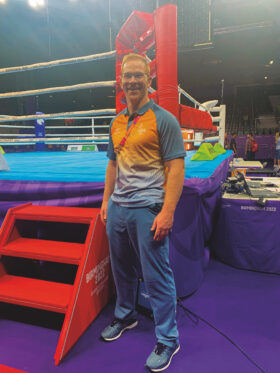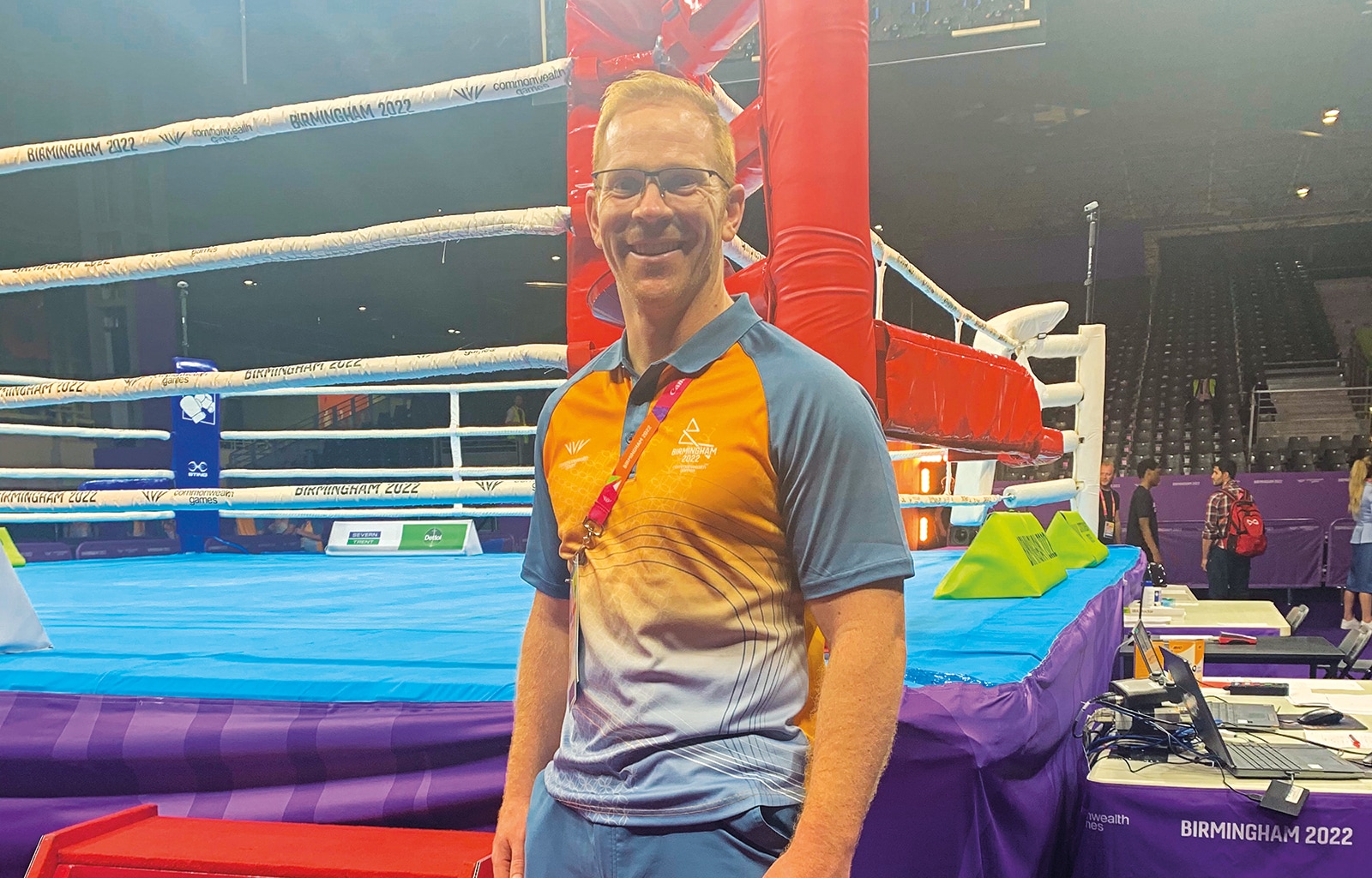Sports dentistry’s european experts meet
A look at the career of Sports Dentist John Haughy, ahead of the Clyde Munro sponsored European Association for Sports Dentistry International Symposium
When at school John Haughey was contemplating which career to pursue, he thought about becoming a doctor. He had the grades.
But John was also a keen athlete and the hours demanded in qualifying and working shifts in general practice would have left little time for sport. Keen to still work in healthcare, his PE teacher suggested dentistry; while also demanding, he could work at and enjoy both.
After graduating from Queens University Belfast, John did his vocational training in Carlisle and worked in the northeast of England before he and some friends decided that some time in the sunnier climes of Australia appealed.
I've been very fortunate in having the experience of working in major competitions as a field of play dentist
While a keen Gaelic footballer, John was also interested in its American counterpart and a big story at the time was the use by 2010 Super Bowl winners, the New Orleans Saints, of the Pure Power Mouthguard. It is a product which was said to not only protect players’ teeth but also, through its design and effect on the body’s behaviour, enhance their performance.
The mouthguard has its basis in the science of neuromuscular dentistry, which focuses on the relationship between the jaw muscles, nerves and occlusion of the teeth.
The dentist John was working for in Australia had an interest in the field. “It was the combination of the publicity around the mouthguard and exposure to neuromuscular dentistry that sparked my interest in sports dentistry,” he said.
On returning to practise in Ireland, John undertook a course in sports dentistry at the UCL Eastman Dental Clinic run by Peter Fine, who has since developed it into an MSc (of which John is now a Clinical Teaching Fellow). This was in the run-up to the 2012 London Olympics and it led to John being recruited as an emergency field of play dentist at test events and during the Games.

Two years later, he was in Glasgow for the Commonwealth Games where he was a member of the athlete medical team, responsible for the oral health of athletes competing in boxing, judo, wrestling, powerlifting, netball and gymnastics. Since then, he has worked at the 2015 European Games in Baku, the 2016 Summer Olympics in Rio, the 2017 Islamic Solidarity Games in Baku and the 2022 Commonwealth Games in Birmingham.
As well as his work with major sporting competitions, John has also researched the effect of the lower jaw position on athletic performance, while completing his MSc in neuromuscular therapy, and contributed a chapter, Delivering Dental Facilities at Sporting Events1, to the sports dentistry book Sports Dentistry: Principles and Practice.
“So, I’ve been very fortunate in having the experience of working in major competitions as a field of play dentist,” said John, “but also in watching sports dentistry grow as a field, particularly because of the knowledge gained from UCL.”
The importance of oral health in sport
The part that oral health plays in sporting performance has been highlighted by the work of Dr Ian Needleman and Dr Julie Gallagher, of the UCL’s Centre for Oral Health and Performance.
It includes one of the largest evaluations of oral health at a multi-sport competition2, the first state of the science summary of what was known about oral health in elite and professional sport3, the most comprehensive study of oral health in professional football4, the largest epidemiological study of the oral health of elite athletes undertaken5, an investigation into athlete-reported oral health behaviours, risks to oral health and potential for behaviour change6 and a feasibility study of implementing behavioural change to enhance oral health behaviours in elite athletes7.
Many high profile sports people have been adversely affected by poor oral health, ignoring dental conditions which have subsequently caused them to miss training or withdraw from competition. Increasingly, there is also an understanding of the effect that poor oral health can have on sports people’s systemic health. In addition, from the work of Sophie Cantamessawith France’s national football team, there is evidence that poor oral health slows players’ recovery from injuries sustained on the field.
John is chairing the third International Symposium of the European Association for Sports Dentistry (EAS4D), sponsored by Clyde Munro, which is being held in Edinburgh on 24-25 November. It aims to bring together sports dentistry and medicine – and analyse how they work together for athletes’ health. Sports dentists and physicians will highlight the important elements in preventing injuries and monitoring health.
About EAS4D
The EAS4D was founded in Paris in 2016. The following year, the EA4SD became an official partner of the European College of Sports and Exercise Physicians (ECOSEP), the first international sports physicians’ association to create a sports dentistry committee. In 2018, the World Dental Federation (FDI) created the first official guidelines and toolkit for sports dentistry8, available to more than one million dentists and 200 national dental associations in more than 130 countries.
In 2019, the EA4SD became an official partner of the Academy for Sports Dentistry in America, thus creating a global network of sports dentistry and starting strategic cooperation in terms of development and the network. In 2020, the first Consensus Statement on sports dentistry integration in sports medicine9, was published in the Journal of Dental Traumatology, by the EA4SD, ECOSEP and ASD.
Thanos Stamos, co-founder of the EAS4D, said: “When I started to treat professional football players and other athletes in my dental clinic, I soon realised that the existing examination and treatment protocols were not enough to provide the best possible dental care to athletes who were traveling at least twice a month, exercising hard every day, and competing at their maximum twice a week.
“The athlete had no time, or the motivation, for dental treatments. The coach wanted the athlete available for training. The team physician wanted the minimum ‘return-to-play’ time (the decision-making process of returning an injured or ill athlete to practice or competition). Overall, there was a complete lack of awareness in sports about the importance of oral health in overall health and physical activity.
“It was a challenging time to be a dentist treating sports people. What would a football player in possession of the ball do while being challenged by an opponent? He would look for teammates. Luckily, there were a lot of dentists in a similar situation, so there were ‘teammates’ on the field.
“It did not take long to agree with colleagues from different countries about the European Association for Sports Dentistry (EA4SD), based in Paris. We were motivated by our common vision to adapt our science to athletes’ needs, conduct research, create a network, and present scientific evidence on how oral health has an impact on sports.
“Oral health and dental treatments have an immediate and visible impact on the body, including the cardiovascular, respiratory, and musculoskeletal system, plantar arch, muscle strength, posture, and gait. Caries and periodontal disease are found in highly elevated incidence in athletes.
“Today, thousands of dentists in Europe and around the world are interested in and benefit from this new field in dentistry. The research and scientific evidence about oral health in sports is increasing rapidly, sports dentistry has become continuing education, specialisation, post-graduate diploma in dental faculties, present in major sports medicine and dentistry international conferences.
“Sports dentistry began as an innovation, continued as a sustainable integration in sports medicine and now it is an emerging global trend in the dental and medical field.”
Find out more on the European Association for Sports Dentistry website.
References
- Delivering Dental Facilities at Sporting Events – onlinelibrary.wiley.com
- Oral health at a multi-sport competition – iris.ucl.ac.uk
- Oral health in elite and professional sport – bjsm.bmj.com
- A Comprehensive study of oral health in professional football – bjsm.bmj.com
- epidemiological study of the oral health of elite athletes – onlinelibrary.wiley.com
- Athlete-reported oral health behaviours, risks to oral health and potential for behaviour change –www.nature.com
- A feasibility study of implementing behavioural change to enhance oral health behaviours in elite athletes – bmjopensem.bmj.com
- World Dental Federation (FDI) created the first official guidelines and toolkit for sports dentistry – www.fdiworlddental.org
- Consensus Statement on sports dentistry integration in sports medicine – onlinelibrary.wiley.com

Comments are closed here.